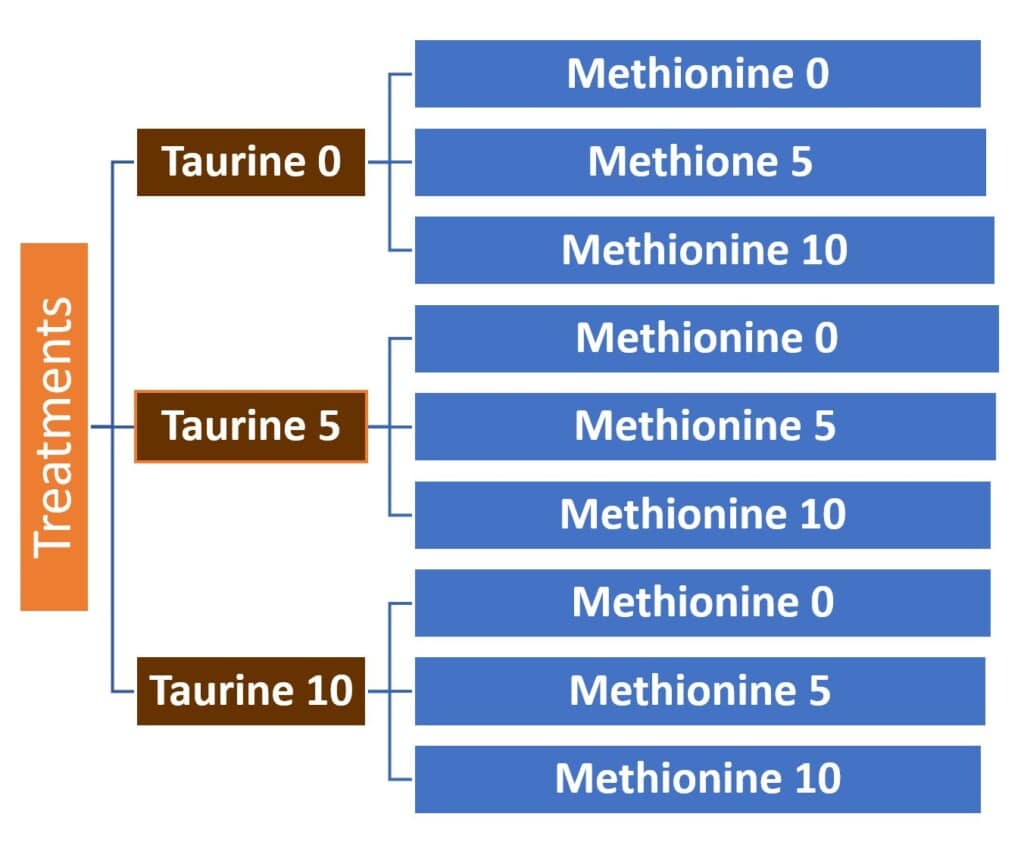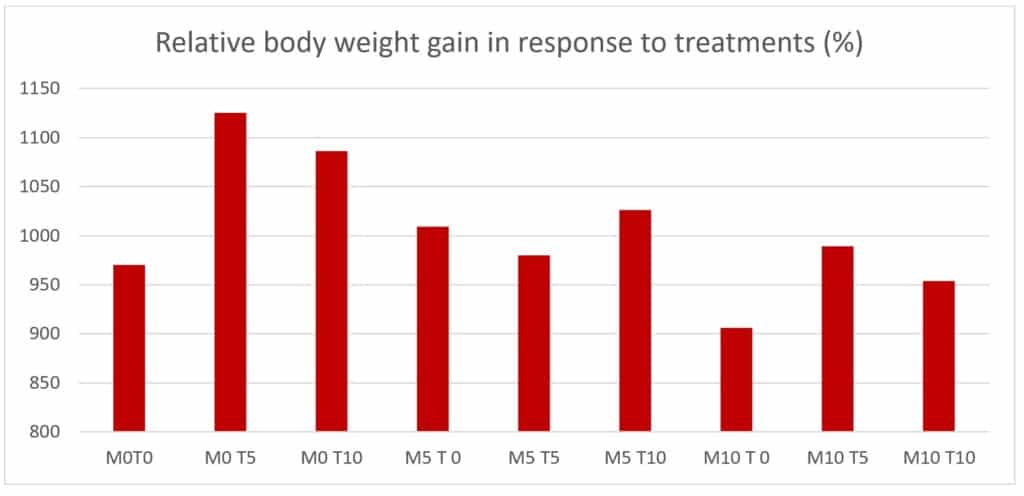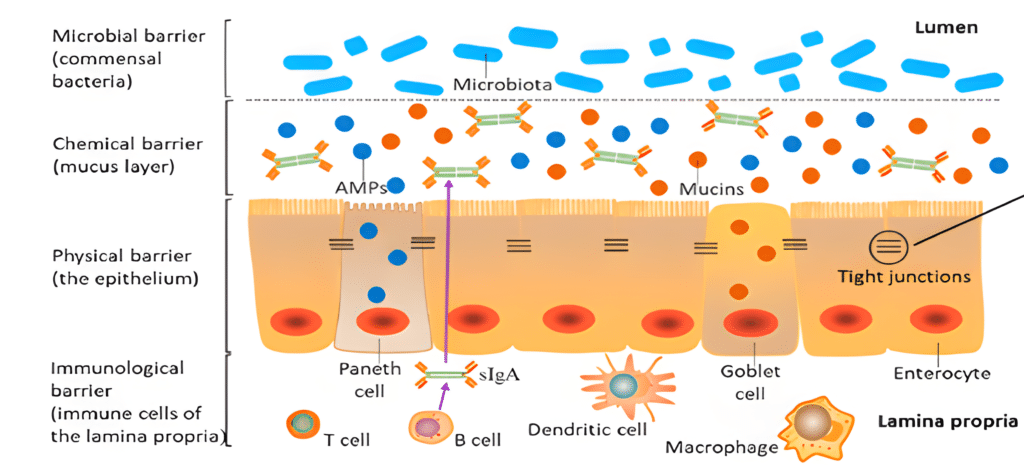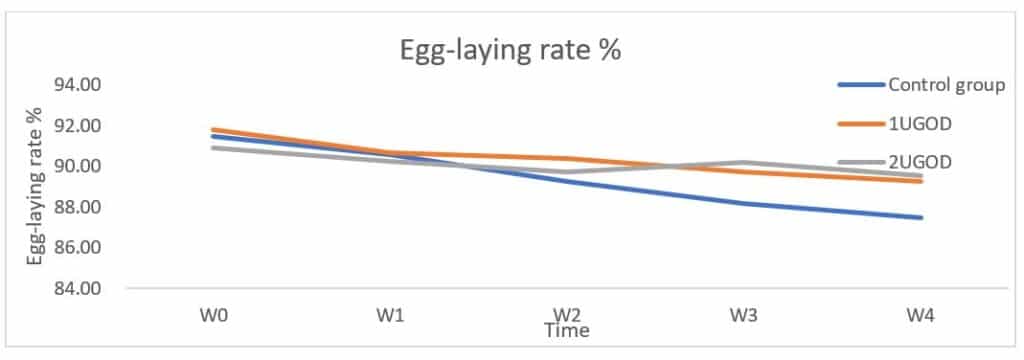It is well known that free range layer chickens’ welfare has been improved. However, the free-range system also provides harsher environments for layer hens to expose to parasites and bacterial challenges. Simultaneously, antibiotics removal trends in layer production require more and more antibiotics alternatives available.
The glucose oxidase (GOD) is exogenously produced by specific fungi fermentation to oxidize β-D-Glucose into gluconic acid and hydrogen peroxide, consuming large amounts of oxygen at the same time in the chicken gut. Therefore, it can protect against oxidative stress and directly kill some pathogenic bacteria or Eimeria parasites. GOD also plays an important role in colour development, flavour, texture, and increasing the shelf life of food products. Due to its characteristics of producing natural acid, deoxygenation and sterilization, GOD has been widely used in animal production.
Recently, Muniyappan et al., (2022) reported an experiment to investigate the graded levels of GOD on egg production and egg quality. On the base of a standard corn-soybean meal diets, 100, 200, and 300 ppm GOD were added to include a total of 4 treatments. The effect of GOD on free range egg production and egg quality was listed in Table 1. It is clearly shown that adding 300 ppm GOD increased free range egg production by 2.2% and significantly reduced broken eggs due properly to increased eggshell quality.
On the base of a standard corn-soybean meal control diet containing probiotics, VTR added 1000 unit /kg GOD plus half dosage of probiotics (GOD 1) and 2000 unit/kg GOD (GOD 2) to include 3 treatments for laying hens. The effect of GOD on laying production rate of 4 weeks was shown in Figure 1. The addition of 2000 unit/kg GOD achieved best results.
A study compiled by our Redox Animal Nutritionists.
Currently most dogs are fed highly processed food that is quite different from canine ancestral diets. Sweeteners are quite often included in processed dog food to mask unpleasant taste or enhance the acceptance of the food.
In the recent years, due to health issues, numerous low-calorie sugar free sweeteners have been developed to replace sucrose. Table 1 shows relative sweetness, acceptable daily intake (ADI) of some of some sweeteners.

Table 1 The relative sweeteners and ADI (mg/kg body weight/day) of some sweeteners
It is noteworthy that xylitol will result in fatal reduction in blood glucose levels and the liver failure has been reported in dogs.
Stevia is a sugar substitute made from the leaves of the stevia plant. it is about 250 to 300 times sweeter than sucrose. However, some people complain it is bitter.
Neohesperidine Dihydrochalcone (NHDC) is a sensory sweetener derived from the hydrogenation of Neohesperidine, a flavanone which is found in the immature fruit of bitter oranges. It is about 1000-1800 times as sweet as sucrose. However, commercially available Sugarex containing 10% NHDC is about 150 times as sweet as sucrose and its recommended dosage rates in dog dry food is 50-150 g/MT.
More importantly, all those alternative sweeteners are not effective substrates for plaque bacteria and therefore less likely result in dental caries. However, it is noticed that approximately 50-88% dogs over three years of age have periodontal disease and adding 0.6% sodium hexametaphosphate significantly reduced the area covered by dental calculus. In cats, it is reported that adding 1.2% lactic acid in a maintenance food significantly inhibited oral substrate accumulation.
Adding NHDC to weaning piglets, calf and fish diets also significantly increase the feed intake of young animals.
Report by Redox Animal Nutritionists
It is well known that reduced protein diets in broiler chickens could lessen nitrogen excretion and environmental pollution. However, the successful strategy for broiler chicken production fed on reduced protein diets largely depends on both exact amino acids balance and sufficient quantity.
Currently ideal amino acids profile and absolute standardised ileal digestible lysine concentrations provide this recommendation on amino acids balance and quantity, respectively. In reduced protein diets, if any amino acid is deficient or limiting, ingestion of excess of other amino acids will result in accumulation of these amino acids in plasma, leading to the reduction in feed intake. Figure 1 clearly shows that when the reduced protein diet is deficient in Arginine, it will result in increased plasma lysine, methionine plus cysteine, threonine, Valine, and isoleucine concentrations, indicating these surplus essential amino acids could not be degraded for muscle growth.

Figure 1. The effect of Arginine deficiency on plasma amino acids concentration (log ug/ml)
Arginine is one of most versatile functional amino acids because it is a precursor of several molecules, such as creatine, ornithine, nitric oxide, citrulline, proline, and polyamines. Apart from protein synthesis, it can stimulate the release of growth hormone and insulin-like growth factor 1.
Arginine also acts as a trigger of target of rapamycin (TOR) signalling system activation for reducing protein degradation. Supplementation of L-Arginine has been approved significantly increase Nitric oxide and reduce ascites related mortality.
In recent updated amino acids profile recommended by Aviagen breeder company, the SID Arginine to SID Lysine ratio has been increased significantly, up to 110% in the finisher period. A 42 days broiler chicken trial conducted in the University of Sydney clearly showed that when SID Arginine to Lysine ratio increased from 107% to 113%, plasma Lysine, methionine plus cysteine, and threonine concentrations were significantly reduced (Figure 2).
Increasing SID valine to Lysine ratio from 76% to 81%, SID isoleucine to lysine ratio from 69% to 73%, and SID Arginine to lysine ratio from 107 % to 113%, increased breast meat by 59 grams.

Figure 2. Plasma lysine, methionine plus cysteine, and threonine concentrations in response to dietary SID Arg/Lys ratios.
Report by Redox Animal Nutritionists
Taurine is a β-amino acid containing a sulfonate instead of a carboxylic group in α-amino acids. It is vital for organ development and aging but not for protein synthesis. Taurine is needed for membrane stabilization, has cytoprotective and cell volume regulation effects, and maintains calcium homeostasis and signalling.
Taurine deficiency impairs growth, fertility, triggers immune deficiency, muscle atrophy, and increased susceptibility of diseases, resulting in a pathological condition known as green liver in strictly marine species due to bile pigments accumulation. Under normal nutritional conditions, fish can produce taurine via methionine-cysteine metabolism pathway.
It is well known that a steady decline of fish meal inclusion levels in aqua cultural feeds has pushed higher inclusion levels of plant protein rich ingredients supplemented crystalline methionine. We assume that the higher level of dietary methionine supplementation might provide a sufficient taurine precursor to support growth rate in fish. However, Gaylord et al (2007) indicated dietary taurine supplementation was indeed beneficial fort rout fed all-plant protein diets, but supplementation of methionine above the requirement could not spare taurine.
Based on the control diet without supplemental methionine and taurine, taurine and methionine were supplemented at 0, 5, or 10 g/kg diet in a 3 x3 factorial design, respectively (figure 1).

Figure 1. 9 experimental diets in 3×3 factorial design.
The relative body weight gains in 9 dietary treatments were shown in Figure 2. There was no interaction (P > 0.05) between Taurine and methionine supplementation. Adding about extra 6.5 g/kg taurine could optimize Rainbow Trout body weight gain.

Figure 2. Relative body weight gain in response to taurine and methionine supplementation
A study compiled by our Redox Animal Nutritionists.
Gut health is important for weaning piglets, in particular when the high dosage of ZnO and antibiotics are removed from piglets feeds..
Apart from the dietary nutrients’ digestion and absorption, the gut is the largest immune organ in pigs and can be divided into four protection layers (Figure 1, Gao et al, 2020).

Figure 1. The different protective layers of the intestinal barrier
The commensal bacterial barrier is a complex environment playing a key role in maintaining the gut health; the chemical barrier consists of the mucus layer secreting mucins and antimicrobial peptides; the physical barrier is composed of epithelial cells and the immunological barrier harbouring the immune cells that secreted immune mediators such as cytokines and antibodies.
Traditionally bile acids are bio-surfactants, assisting intestinal digestion and absorption of lipids and fatty soluble vitamins such as Vitamin A, D, E and K, and thereby improving nutrient utilization. Recently, in the gut epithelial cell, bile acids are identified as signalling molecules to activate a couple of nuclear receptors, namely farnesoid X receptor (FXR), pregnane X receptor (PXR), Vitamin D receptor (VDR) and G-Protein coupled receptor (TGR5). Therefore, bile acids play an important role in regulating epithelial barrier functions.
In 2018, Ipharraguerre et al indicated that currently all alternatives including probiotics, prebiotics, organic acids, essential oils, antimicrobial and plants extracts to antibiotics or high dosage of ZnO underlined their growth promotion action. They demonstrated that either antibiotics or the high dosage of ZnO could activate bile acids receptors and consequently spare nutrients for growth and improve the metabolic efficiency of antibiotics or the high dosage of ZnO treated animals. Therefore, it is necessary for adding the exogenous bile acids to antibiotics free or the high dosage ZnO free diets in weaning piglets.
Based on experimental data in China, Belgium, adding 350 grams per MT feed commercially available exogenous bile acids could improve daily weight gain by 9% and FCR by 7 points.
Report by Redox Animal Nutritionists
Redox the leading distributor of chemicals and ingredients in Australia has acquired the business of Optigen Ingredients Pty Ltd completing the transaction on the 25th of August 2023.
Optigen is an Australian market-leading company specialising in the supply of raw materials and speciality ingredients used in the nutraceutical, pharmaceutical, functional foods, veterinary and animal nutrition market segments in Australia and New Zealand.
Their range includes innovative and specialised ingredients including Vitamins, Amino Acids, Minerals, Natural Oils, Herbal Extracts, Joint Health products, Marine Oils and Veterinary APIs.
CEO and Managing Director Raimond Coneliano said “We’re very excited to add Optigen’s products to our expanding portfolio to benefit our large existing customer base in the Nutraceutical market in addition to extending Redox’s best-in-class service and wide range to Optigen’s existing clients across a range of industry sectors.”
Contact your Redox representative for more information.
Taurine is a β-amino acid containing a sulfonate instead of a carboxylic group in α-amino acids. It is vital for organ development and aging but not for protein synthesis. Taurine is needed for membrane stabilization, has cytoprotective and cell volume regulation effects, and maintains calcium homeostasis and signalling.
Aquatic feeds for farmed fish and shrimp are mainly made from protein rich ingredients such as fish meal, poultry by-product meal, soybean meal concentrate, yeast protein, pea protein concentrate, corn gluten meal and wheat gluten meal.
Historically fish meal has been the protein source of choice and currently there is no alternative to replace fish meal completely. It is probably since most alternative ingredients are deficient in one or more of the ten essential amino acids: lysine, methionine, threonine, valine, isoleucine, leucine, tryptophan, histidine, arginine, and phenylalanine. However, due to the high price and tight supply of fish meal, a steady decline of fish meal inclusion levels in aquacultural feeds has pushed higher inclusion levels of alternative protein rich ingredients supplemented crystalline essential amino acids.
Histidine is an integral component of a broad set of tissues including skin, bone, ligaments, and muscle. It also stimulates the digestive secretion of gastrin, a hormone that is essential for digestion of dietary protein. Histidine deficiency could induce a decrease in amino acids oxidation and a decrease protein turnover. For Atlantic salmon, it is reported that a minimum dietary histidine concentration of 1.4% is needed for the prevention of cataracts. Compared with fish meal, usually animal protein alternatives contain less histidine (Table 1). In Table 1, it is also clearly shown that using wheat gluten meal to replace soy protein concentrate might obtain similar histidine concentration but lower arginine concentration to that in fish meal.

Table 1 some essential amino acids in protein rich ingredients (%)
Histidine is an amino acid that has the most powerful impact on fish palatability and providing adequate levels of histidine is critically important for fish or shrimp growth. For shrimps, the dietary requirement of histidine is about 0.8%, corresponding to 2.2% dietary crude protein level. For Rainbow trout, the dietary requirement of histidine is about 0.6%, corresponding to 1.2% crude protein level. For Nile tilapia, the dietary requirement of histidine is about 1%, corresponding to 1.7% protein level. To prevent leaching of crystalline histidine, fish or shrimp diets can be bound with carboymethylcellulose, corn starch and K-carrageenan.
A study compiled by our Redox Animal Nutritionists.
High dosage of zinc oxide (ZnO) in piglet feed has been widely used to control post weaning diarrhoea (PWD).
In the modern pig industry, weaning generally occurs 21-28 days after birth. The administration of high dosage of ZnO usually lasts about 14 days, starting immediately after weaning. ZnO inclusion in piglets diets should reach an optimal concentration of 2500 ppm Zn (equivalent to approximately 3100 ppm ZnO). Supplementation of high dosage of ZnO not only results in the lower mortality and reduced PWD symptoms but also improves piglets’ growth performance. However, due to its negative environmental impact, the EU commission has banned the use of high dosage of ZnO in weaned piglets diets, allowing 150 ppm Zn supplementation since June 2022 and resulting in significantly increased cost of antibiotics treatments. Table 1. shows the effect of reduced ZnO concentrations on piglets performance.

Table 1. The effect of graded levels of ZnO on piglets’ performance
The coated zinc oxide has the larger surface area and coated with the enterolysis polymer material to avoid acidic stomach loss. Therefore, coated ZnO could significantly reduce ZnO supplemental levels but achieve the equivalent effect to the high dosage of ZnO. Table 2 compared the effect of normal ZnO with coated ZnO. It is clearly shown that using 1500 ppm coated ZnO (900 ppm Zn) achieved the equivalent effect on piglets’ daily gain and diarrhea rate. If supplemental level of coated ZnO is below 1500 ppm, it will compromise piglets daily gain and increase the diarrhea rate.

Table 2 The effect of graded levels of coated ZnO on piglets’ performance
A study compiled by our Redox Animal Nutritionists.
Our warehouses will be closed for an essential Stocktake on Thursday, June 29th and Friday, June 30th.
Consequently, the final deliveries before the closure will occur on Wednesday, June 28th.
Normal operations will resume on Saturday, July 1st ready to serve you with our usual efficiency and reliability.
Please ensure you plan your orders accordingly, considering this temporary interruption in our operations. We understand the significance of maintaining a seamless supply chain for your business needs, and we appreciate your understanding and cooperation during this period.
Should you have any questions or require further assistance, please do not hesitate to contact our customer support team, who will gladly assist you.
Tannins are polyphenolic commands and the secondary metabolites of higher plants. Tannins are generally classified as condensed tannins, hydrolysed tannins and phlorotannins. Condensed tannins consist of flavan-3-ol subunit linked together to form oligomers and polymers, whereas hydrolysed tannins are easters of gallic or ellagic acid linked to polyol core.
Phlorotannins are structurally less complexed and occur only in marine brown algae. Because secondary metabolites serve as a part of plant chemical defence system against invasion by pathogens and attack by insects, tannins have shown antimicrobial, anti-parasitic, antioxidant, anti-inflammatory and anti-virus properties. Recently it was reported that condensed tannins significantly reduced methane emission, but hydrolysed tannins failed to affect methane reduction. However, both condensed tannins and hydrolysed tannins reduced Nitrous Oxide emission.
Feedlot and pasture frothy bloat is a serious and often fatal digestive disorder that develops in cattle or sheep when gas produced during fermentation of feeds is trapped within the rumen in the stable form and prevent eructation. Moderate levels of condensed tannins (<50 g/kg DM) reduce protein degradation in the rumen without depressing rumen fibre digestion or DM feed intake. It is generally believed that condensed tannins may bind protein in the rumen and reduce foam stability by avoiding microbial degradation and be absorbed in the small intestine.
Tannins exert their anti-parasitic effect by decreasing the viability of larvae, thus interfering with egg hatching, and improving the immunity (Table 1). Some tree bark is rich in plant second metabolites, especially condensed tannins.
Recently it was demonstrated that the tree bark-stripping behaviour is primarily for ruminants to acquire condensed tannins to repel gastrointestinal parasites.

Table 1 Effect of grazing condensed tannins forages and control forages on parasite state.
A study compiled by our Redox Animal Nutritionists.
Our Partnering Manufacturers

